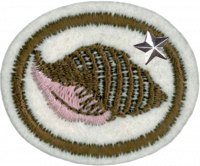AY Honor Shells - Advanced Requirements
1. Have the Shells honor.
2. Define the term "mollusca" or "mollusk."
3. Learn the classification terms of mollusks, know the distinguishing characteristics of each, and become acquainted with several species under each class.
4. Distinguish between univalve and bivalve mollusks from the following considerations:
- a. Shell
- b. Mollusk body
- c. Reproduction
- d. Movements
- e. Securing food
- f. Self-preservation
5. Identify from shells or drawings and know the meaning of the following concho logical terms:
- a. Valve
- b. Apex
- c. Aperture
- d. Byssus
- e. Foot
- f. Mantle
- g. Operculum
- h. Mother of pearl
- i. Epidermis
- j. Ribs
- k. Teeth
- l. Concentric lines
- m. Canal
- n. Spines
- o. Whorls
- p. Lips
6. Explain the development of a shell. How long do mollusks live?
7. Give some facts about the life of a Strombus pugilis (fighting conch) and explain why this shell is so named.
8. Explain the activities of the shipworm.
9. What accounts for the distribution of mollusks.
10. Name two mollusks that have no shells.
11. Find answers for the following interesting questions:
- a. How are bivalve and univalve animals fastened to their shells?
- b. How is shell color controlled?
- c. What mollusk has four gills?
- d. From what sea animal was India ink formerly made?
- e. What mollusk spins a silken thread?
- f. What shells were used for money by ancient tribes?
- g. What shell is considered sacred by the Tibetans?
- h. Purple dye of ancient times came from the secretion of what mollusk?
- i. What is the source of pearls? How are they formed?
12. Name six commercial uses for shells.
13. Do one of the following:
- a. Personally find and collect 40 species of shells. List each shell as to the place and date it was found, common name, scientific name, and class.
- b. Make a collection of 50 species of shells you have found, received, or purchased.
- List each shell collected as follows: if personally found, give the information called for under letter "a" above; if received or purchased, give the name of the person from whom the shell was received, the habitat of the shell, the date of its acquisition, and its common name, scientific name, and class.


